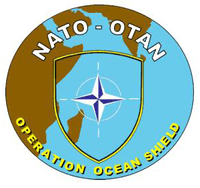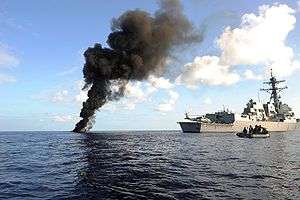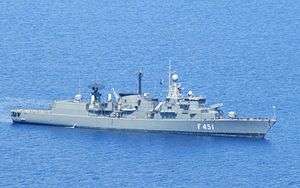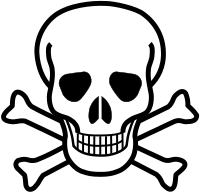Operation Ocean Shield
Operation Ocean Shield was NATO's contribution to Operation Enduring Freedom – Horn of Africa (OEF-HOA), an anti-piracy initiative in the Indian Ocean, Guardafui Channel, Gulf of Aden and Arabian Sea. It follows the earlier Operation Allied Protector. Naval operations began on 17 August 2009 after being approved by the North Atlantic Council, the program was terminated on 15 December 2016 by NATO.[4] Operation Ocean Shield focused on protecting the ships of Operation Allied Provider, which transported relief supplies as part of the World Food Programme's mission in the region. The initiative also helped strengthen the navies and coast guards of regional states to assist in countering pirate attacks. Additionally, China and South Korea sent warships to participate in these activities.
| Operation Ocean Shield | |||||||
|---|---|---|---|---|---|---|---|
| Part of Operation Enduring Freedom – Horn of Africa | |||||||
  USS Farragut destroying a pirate skiff in the Gulf of Aden (March 2010) | |||||||
| |||||||
| Belligerents | |||||||
Non-NATO: |
| ||||||
The US Navy was the largest contributor of ships, followed by the Indian Navy.[5][6] The taskforce was composed of ships from the contributing navies, led by a designated leadship. The role of leadship was rotated among the various countries involved. In October 2015 this was the Turkish frigate TCG Gediz.[7]
Allies and other organisations
"Pirate attacks off the vast coastline of Somalia declined from 236 in 2011 to two reportedly unsuccessful attacks in 2014, thanks to international counter-piracy cooperation efforts as well as armed guards now stationed on most large ships that traverse the region's waters. NATO has indicated that while it will be ending its mission in the Indian Ocean, the organization "will remain engaged in the fight against piracy by maintaining maritime situational awareness and continuing close links with other international organisation's counter-piracy actors."[8] NATO has been supporting international efforts to combat piracy in the Indian Ocean, as well as in the Gulf of Aden and off the Horn of Africa since 2008, at the request of the United Nations. It had been working alongside other missions including the European's Union's Operation Atalanta, the US-led Combined Task Force 151 and other individual countries such as China, Japan, and South Korea."[8]
NATO's success in the area was due in part to the co-operation of other foreign states with interests in the region. A lot of these informal connections took place at SHADE (Shared Awareness and Deconfliction) meetings. These meetings allowed for shared tactics among a large of international entities, including China, Japan, Russia, India and South Korea but is definitely not limited to them. With NATO promoting co-operation amongst these foreign entities, Operation Ocean Shield could effectively protect the area. They also utilized EUNAVFOR’s innovative electronic network called Mercury which shared anti-piracy tactics with other task forces and operations. Since this was an informal system, it wasn't weighed down with bureaucracy and could be spread amongst other coalitions and governmental organisations and could effectively help anyone that needed precise information in the area.[9]
Anti-piracy operations
On 10 January 2010, Admiral Pereira da Cunha, of the Portuguese Navy held a meeting regarding piracy with the Puntland coast guard. It was held aboard the frigate NRP Álvares Cabral near Bosaso, Somalia and focused on human intelligence gathering, capacity building and counter piracy co-operation between NATO and Puntland authorities.[6]
Pirates attacked the Panamanian flagged merchantman MV Almezaan on 25 March. One pirate was killed by Almezaan's crew during the boarding and shortly afterwards the Spanish Navy frigate Navarra arrived and launched a helicopter. Warning shots were then fired and the pirates surrendered without further conflict. Six pirates were taken prisoner for a short time before being released in two skiffs and the mother ship was sunk by gunfire.[10]
The small Seychelles Coast Guard patrol boat Topaz engaged in another battle with pirates five days later on 30 March. While patrolling just off the coast of Somalia, Topaz encountered a captured dhow. After warning shots were fired, the dhow seemed to ignore the patrol boat and its occupants eventually opened up with rocket-propelled grenades and small arms fire. The Seychellois then engaged and after shooting off 10,000 rounds of machine gun fire, the dhow was burning and eventually sank. Twenty-seven members of the dhow's crew were rescued and the Topaz was returning to base when she was attacked by a trawler and two skiffs. Again the Seychellois responded with counter battery and the trawler exploded. One of the skiffs was sunk as well. Pirate casualties are unknown and one member of the dhow's crew was wounded.[11]
USS Nicholas was attacked by a skiff on 1 April, while in the waters between the Seychelles and Kenya. The Americans returned fire briefly and three pirates surrendered. Nicholas then pursued a mother ship vessel for a while, a boarding team was put on the ship and it was captured. A little later that day, USS Farragut was also operating in the area and she captured thirteen more pirates. This was following the attempted seizure of the Sierra Leone flagged tanker MV Evita. The crew of the tanker defended their ship with flares and outmaneuvered the pirates.[12]
_during_Standing_Naval_Force_Atlantic_exercise_with_USS_Trenton_(LPD-14)%2C_USS_Saipan_(LHA-2)%2C_and_USS_Simpson_(FFG-56)_in_background_040925-N-8327M-001.jpg)
Operation Dawn of Gulf of Aden was launched by Republic of Korea Navy Special Warfare Brigade commandos with support from Oman and the United States in January 2011. Following the capture of the Norwegian owned chemical tanker MV Samho Jewelry on 15 January off Muscat with its crew of twenty-one, a failed boarding action was carried out on 18 January which resulted in the wounding of three commandos. A second attempt on 21 January succeeded in freeing the ship and the captives while eight pirates were killed altogether.[13]
A failed rescue operation was carried out by the Danish frigate HDMS Esbern Snare and a Seychellois Coast Guard patrol boat on 26 January. MV Beluga Nomination was taken over four days before and the attackers cut into the freighter's citadel with a blow torch to get at the crew. The Seychelles patrol boat and Esbern Snare were dispatched and when they found the pirates and engagement began. Boarding teams from the patrol boat were repulsed but the Seychellois were able to kill one or two of the pirates. Two of Beluga Nomination's crew managed to escape in a lifeboat and were rescued by the Danish though four others were killed either by drowning or the pirates. Ultimately the operation was aborted and the pirates sailed away with the tanker and seven remaining hostages.[14]
The Quest incident occurred in February 2011. In the first attack on an American private ship since the Maersk Alabama hijacking in 2009, the yacht SV Quest was taken over by nineteen pirates on 4 February. The United States Navy responded by dispatching the aircraft carrier USS Enterprise, the guided missile cruiser USS Leyte Gulf and the guided missile destroyers USS Bulkeley and USS Sterett to release the four captives. The ships found Quest on or about 21 February off the coast of Oman and negotiations to free the hostages began. However, on the following day, the pirates opened fire on USS Sterret with rocket propelled grenades and shortly thereafter small arms fire was heard. The American commander then ordered a team to board the yacht and after doing so, all four of the prisoners were found to have been killed by the pirates. Fifteen pirates were taken into custody and two of them were killed in the boarding action. The bodies of two other pirates were also found but American officials have no explanation for the cause of their deaths.[15]
On 5 May 2011, as part of Operation Ocean Shield, the aircraft carrier USS Carl Vinson, the guided-missile cruiser USS Bunker Hill, and the Turkish frigate TCG Giresun responded to a distress call from the Panamanian-flagged, Chinese-owned bulk carrier MV Full City. An Indian Navy Tu-142 maritime patrol aircraft located Full City, and while TCG Giresun boarded the merchant vessel, USS Bunker Hill and its embarked helicopters intercepted a dhow believed to be the "mothership" for the pirate attack. Bunker Hill's VBSS boarding party seized weapons and other equipment commonly used in piracy, and the boarding party also sank a small skiff being towed by the dhow. Giresun's boarding party found Full City's Chinese crew safe and in control of their ship.[16][17][18]
Piracy during the operation
NATO's vehicles have a specific mandate to provide protection and deterrence of piracy in its territorial waters. All members of NATO help make the operation a success via funding or through ships. NATO Allies provide ships and maritime patrol aircraft to NATO Standing Maritime Groups, which in turn assigns a number of ships, on a rotational basis, to Ocean Shield.[19] "In January 2013, there were no attacks, approaches or disruptions in the area. In comparison, in January 2012, there were four pirate attacks in which all were unsuccessful. Additionally, out of 80 suspected pirates captured by counter piracy forces, 59 were captured by NATO ships. In January 2011, there were 29 attacks and six ships were captured."[19] Arguably the operation has succeeded in decreasing piracy in the region while the task force was in power.
Conclusion of Operation Ocean Shield
The conclusion of Operation Ocean Shield occurred on 16 December 2016. The final operation was led by Danish pilots in an attempt to map the Somali coastline and the gulf of Aden. The Danes' task was to map the inlets, camps and large cities of the coast for an intelligence report. "The detachment covered 1.800 km of coastline in which intelligence specialists reviewed and disseminated photographs and video files to produce the intelligence picture."[20]
NATO is reallocating resources to the Mediterranean to deal with the immigrant crisis and human smuggling but believes that the efforts put into the gulf of Aden will help stem the tide of returning piracy or prevent it altogether.[9] As with the change in the political environment and world new problems have arisen where NATO has had to allocate resources. Therefore, it justifies the funding of the Mediterranean operation.[9]
Business sector regrowth
Through the use of the NATO shipping centre and the private sector, the Ocean Shield task force could effectively reduce the response time of counterattacks and warning businesses about potential threats in their shipping lanes. Through this co-ordination the shipping industry didn't need to slow down as much by taking in direct routes through other less safe international waters.
Piracy attacks since the ending of Operation Ocean Shield
Piracy attacks have occurred since Operation Ocean Shield has ended. Gunmen hijacked the Aris 13, a small oil tanker, on 13 March 2017 and have demanded a ransom for the crew. Industrial shipping companies are trying to figure out if piracy is back in the region or this is going to be a rare occurrence,[21] as this was the first case of Somali piracy in a good half-decade and of the new year. More and more attempts of cargo theft via piracy occurred in 2017.[22]
Vessels deployed
_underway_in_the_Atlantic_Ocean_on_15_July_2005_(050715-N-8163B-020).jpg)
.jpg)

| Ship | Type | Branch |
|---|---|---|
| USS Enterprise (CVN-65) | aircraft carrier | USN |
| USS Carl Vinson (CVN-70) | aircraft carrier | USN |
| USS San Jacinto (CG-56) | guided missile cruiser | USN |
| USS Leyte Gulf (CG-55) | guided missile cruiser | USN |
| USS Bunker Hill (CG-52) | guided missile cruiser | USN |
| USS Farragut (DDG-99) | guided missile destroyer | USN |
| USS Bulkeley (DDG-84) | guided missile destroyer | USN |
| USS Sterett (DDG-104) | guided missile destroyer | USN |
| USS Donald Cook (DDG-75) | guided missile destroyer | USN |
| USS Laboon (DDG-58) | guided missile destroyer | USN |
| USS Bainbridge (DDG-96) | guided missile destroyer | USN |
| USS Stephen W. Groves (FFG-29) | guided missile frigate | USN |
| USS Kauffman (FFG-59) | guided missile frigate | USN |
| USS Nicholas (FFG-47) | guided missile frigate | USN |
| USS De Wert (FFG-45) | guided missile frigate | USN |
| KD Sri Indera Sakti | flexible support ship | RMN |
| MT Bunga Mas Lima | auxiliary ship | RMN |
| HNoMS Fridtjof Nansen (F310) | Multi-role Frigate | RNoN |
| HMS Cornwall (F99) | frigate | RN |
| HMS Chatham (F87) | frigate | RN |
| HMS Montrose (F236) | frigate | RN |
| HMNZS Te Mana (F111) | frigate | RNZN |
| HDMS Esbern Snare (L17) | flexible support ship | RDN |
| HDMS Absalon (L16) | flexible support ship | RDN |
| HDMS Iver Huitfeld (F361) | frigate | RDN |
| HNLMS Rotterdam (L800) | Landing Platform Dock | RNN |
| HNLMS Tromp (F803) | frigate | RNN |
| HNLMS Zeeleeuw (S803) | submarine | RNN |
| Bersagliere (F 584) | frigate | MM |
| Libeccio | frigate | MM |
| ROKS Chungmugong Yi Sun-Shin (DDH-975) | destroyer | ROKN |
| ROKS Choi Young (DDH-981) | destroyer | ROKN |
| INS Tabar (F44) | frigate | IN |
| INS Mysore (D60) | destroyer | IN |
| INS Tir (A86) | training ship | IN |
| INS Kalpeni | fast attack craft | IN |
| INS Cankarso | fast attack craft | IN |
| HMCS Fredericton (FFH 337) | frigate | RCN |
| NRP Vasco da Gama (F330) | frigate | MP |
| NRP Dom Francisco de Almeida (F334) | frigate | MP |
| Álvaro de Bazán (F101) | frigate | Spanish Navy |
| Navarinon (F-461) | frigate | HN |
| Limnos (F-451) | frigate | HN |
| TCG Giresun (F 491) | frigate | TN |
| PNS Babur (D182) | frigate | PN |
| PLANS Chao Hu (FFG 568) | guided missile frigate | PLAN |
| JDS Sazanami (DD-106) | destroyer | MSDF |
| JDS Umigiri (DD-158) | destroyer | MSDF |
| Hetman Sahaydachniy (U130)[3] | frigate | VMSU |
| ARC 7 de Agosto (47) | offshore patrol vessel | ARC |
In addition to the frigate HNoMS Fridtjof Nansen (F310), Norway has previously had a Lockheed P-3 Orion involved in the operation.
See also
| Wikimedia Commons has media related to Operation Ocean Shield. |
- Combined Task Force 151 – multinational force in the area
- Operation Atalanta – EU force in the area
- Piracy in the Strait of Malacca
- Piracy in the Gulf of Guinea
- Piracy on Falcon Lake
References
- ""Fuerzas Militares pueden enfrentar cualquier amenaza interna o externa": Mindefensa". Retrieved 25 June 2016.
- "New Zealand joins NATO's counter-piracy mission Ocean Shield". NATO. 21 January 2014. Retrieved 23 November 2014.
- Thys, John (22 February 2013). "Ukraine Joins NATO's Counter-Piracy Operation". RIA Novosti. Retrieved 26 April 2013.
Kozhara: Hetman Sahaidachny frigate to join NATO’s anti-piracy operation, Interfax-Ukraine (17 September 2013) - https://www.nato.int/cps/en/natohq/topics_48815.htm
- "Operation Ocean Shield". Manw.nato.int. Archived from the original on 13 May 2011. Retrieved 19 May 2011.
- "2009 Operation Ocean Shield News Articles". Manw.nato.int. Archived from the original on 29 April 2011. Retrieved 19 May 2011.
- "Operation Ocean Shield". NATO. Archived from the original on 3 October 2015. Retrieved 2 October 2015.
- "NATO ends Ocean Shield | Maritime Security Review". www.marsecreview.com. Retrieved 10 April 2017.
- ""Ocean Shield" Achieved its Mission". maritime-executive.com. Retrieved 10 April 2017.
- "Ministerio de Defensa – La 'Navarra' intercepta dos esquifes y un barco nodriza". Defensa.gob.es. Retrieved 19 May 2011.
- Thome, Wolfgang H. (30 March 2010). "Robust Response Seychelles Coast Guard intercepts pirates and rescues crew". eTurboNews.com. Retrieved 19 May 2011.
- "Five Somalis sentenced to life in piracy case". CNN. Retrieved 19 May 2011.
- "South Koreans pull off daring rescue of pirated ship". CNN. Retrieved 19 May 2011.
- "Entführtes deutsches Schiff: Tödliches Feuergefecht um gekaperte "Beluga Nomination" – SPIEGEL ONLINE – Nachrichten – Panorama". Der Spiegel. Retrieved 19 May 2011.
- "Quest incident – the final moments". Sail-World.com. 28 February 2011. Retrieved 19 May 2011.
- "US Navy, International Forces Respond to Piracy Attack". NNS110506-15. U.S. 5th Fleet Public Affairs. 6 May 2011. Retrieved 10 May 2011.
- Mass Communication Specialist 2nd Class Byron C. Linder, USN (9 May 2011). "Carrier Strike Group One Arrives in 7th Fleet". NNS110509-01. USS Carl Vinson Public Affairs. Retrieved 10 May 2011.
- "Indian Navy thwarts pirate attack; rescues Chinese vessel, crew". NDTV. Indo-Asian News Service. 6 May 2011. Retrieved 10 May 2011.
- "Allied Maritime Command – Operation OCEAN SHIELD". mc.nato.int. Retrieved 10 April 2017.
- "Danish pilots conduct operation Ocean Shield's final patrol". Naval Today. Retrieved 10 April 2017.
- "Somalia pirates: Anger fuels return of ship attacks". Al Jazeera. Retrieved 10 April 2017.
- "Live Piracy Map". icc-ccs.org. Retrieved 17 April 2017.
- "Archived copy" (PDF). Archived from the original (PDF) on 27 September 2011. Retrieved 12 May 2011.CS1 maint: archived copy as title (link)
- "Archived copy" (PDF). Archived from the original (PDF) on 27 September 2011. Retrieved 12 May 2011.CS1 maint: archived copy as title (link)
